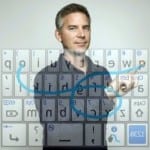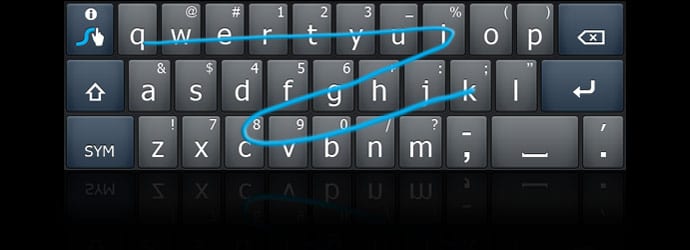 Orphaned as the “tech twin” that time forgot, keyboard technology has languished far behind advances in video displays and computer chip processing in achieving the kind of power that is placed at our fingertips. But not anymore. With a master stroke, or swipe, of a stylus or finger, the keyboard is finally being reinvented on the “glidable” glass surface of cell phones and tablets. This revolution won’t be televised. It will be typed, or “swyped,” and from right here in Seattle.
Orphaned as the “tech twin” that time forgot, keyboard technology has languished far behind advances in video displays and computer chip processing in achieving the kind of power that is placed at our fingertips. But not anymore. With a master stroke, or swipe, of a stylus or finger, the keyboard is finally being reinvented on the “glidable” glass surface of cell phones and tablets. This revolution won’t be televised. It will be typed, or “swyped,” and from right here in Seattle.
Using “predictive intelligence” that knows what it is you are trying to convey even before you have finished entering it, Seattle’s Swype is changing the face of text entry forever. Not with a tap, mind you, but with a gesture. The “Seattle Swype” is an imaginary line drawn across the keys from the first letter of a word through the middle characters and ending on the last. So instead of having to register every individual character of the alphabet with a key press, with Swype you can connect the dots of your thoughts. As anyone with a physical disability, from the most severly challenged to the legions of carpal tunnel and repetitive stress injury sufferers will attest, it has arrived not a moment too soon!
Seattle is the spawning ground for what is turning out to be the transformation of typing as we know it. The “T9” system that was invented here a few short years ago by Swype co-founder and CTO, Cliff Kushler, is now installed on over 4 billion devices. Amazingly, the inspiration for T9 was the interest of its inventor in bridging the language gap between people and animals.
 The WTIA has just named Swype a finalist for this years Industry Achievement Awards in the category of Consumer Product or Service of the Year. We spoke with company CEO Mike McSherry on a day that may live in history for “typists” everywhere. On this day, when Swype was getting plenty of kudos for its breakthroughs, pending patents were announced for what could become an Apple multi-touch keyboard. Is it a swipe at Swype? McSherry doesn’t think so.
The WTIA has just named Swype a finalist for this years Industry Achievement Awards in the category of Consumer Product or Service of the Year. We spoke with company CEO Mike McSherry on a day that may live in history for “typists” everywhere. On this day, when Swype was getting plenty of kudos for its breakthroughs, pending patents were announced for what could become an Apple multi-touch keyboard. Is it a swipe at Swype? McSherry doesn’t think so.
Seattle24x7: Congratulations, Mike, on your selection as a WTIA finalist, and on an incredible year for Swype. Swype is revolutionizing typing in a year where new technologies and form factors like tablets are stealing headlines. Is Apple’s acquisition of FingerWorks (2005) and the rumors of an Apple multi-touch keyboard system a healthy competitor for Swype?
McSherry: One of the things we talk about with OEM’s is that there are literally 30 different keyboard layouts around the world. So from a manufacturing and inventory management perspective, you’re trying to keep your Cyrillic keyboard and your French keyboard and your German keyboard on hand. It adds up to manufacturing costs, inventory costs, inefficiencies, and so on. In our case, a virtual keyboard is just the software related to all of that. So you can have one device that can handle any of those needs. As to incorporating a mouse into it, you know, with more finger gesturing, you don’t need to drive the mouse as much. Your finger can drive the mouse. So it makes sense to me.
Seattle24x7: Is this why Apple bought FingerWorks?
McSherry: FingerWorks, from what I can understand, is multi-gesture. So you drag three fingers down and there is an action. Or you drag 4 fingers down and there is a different action. The FingerWorks patents have nothing to do with the keyboard or disambiguating the letters that you draw over in trying to predict a word.
Seattle24x7: Compared to traditional keyboards, Swype works on a smooth glide path?
McSherry: Right, so a glass surface seems to make a lot more sense, versus dragging your finger across a bumpy surface. Swype works with remote controls on TV’s and even hand gestures that are detected by, say, Microsoft Kinect. So you don’t need a flat screen, per say, but you need a screen. And you interact with that screen via touch, remote control or finger gestures. Swype works in all those different environments.
Seattle24x7: Besides tablets, we’re seeing a lot more of the flat or low profile keyboards these days?
McSherry: Randy Marsden, who co-invented Swype along with Cliff Kushler, also invented Clean Keys, a touch keyboard that was invented for a medical environment. It’s very easy to clean and gets rid of germs.
Seattle24x7: The advantages in productivity and speed seem undeniable. Swype has already won several world records for speed and accuracy.
McSherry: In conventional typing, every single time you put your finger down, you have to be accurate and precise. Whereas with Swype you only need 2-dimensional control. That means once you put your finger firmly down on that glass surface, you can keep it pressured and then move your finger over the letters of the keys. It’s much easier for people with weak, feeble, or severe arthritic conditions.
I think right out of the gate, using Swype you can easily get to 30 words per minute in the short term. Once you get familiar with the product, you can achieve 40 plus words and the World Guinness Record attempts using Swype show people are averaging over 70 words per minute.
The competitions have been popular. We’ve broken the Guinness World Record for fastest text message on a touchscreen device twice. Last year, Franklin Page, a former Swype employee and Seattle resident, set the record, which was part of a national ad campaign for Samsung.
What some people don’t know is that Swype was born out of disability research and just this past week, a quadriplegic set a new Guinness World Record for fastest hands-free typing using Swype.

Seattle24x7: Wrapping up on the Apple topic, the iPhone and iPad keyboards seem like they would be very prominent candidates for Swype, and yet their system is closed, compared to Android, and, say, the Samsung Galaxy tablet where you can use Swype out of the box?
McSherry: Yea, if Apple did not close their keyboard APIs, we could be in the App store and possibly replace the iPhone keyboard as the users’ keyboard of preference. From what we understand, Apple’s keyboard and text input experience are so core to their UI experience and, as we know, Apple likes to tightly control the end-to-end user experience..
Android is, indeed, different and we are featured on the Samsung Galaxy tablet and other Android tablets as a real point of difference, I also think it’s likely you’ll see us launching on Windows 7 tablet platforms. With the disability realm we’re using Windows 7 on desktop machines and peripheral devices.
Seattle24x7: Switching keys, or topics, what can you tell us about doing business here in Seattle?
McSherry: Seattle’s a fabulous spot for us. Since Cliff Kushler, the co-founder and inventor of Swype, started his earlier company, T9, here in Seattle, we’ve been able to hire a number of people with direct experience. We’ve also found experts in supporting text input via language development, keyboard knowledge and grammatical language structure. It’s a fairly new skill set so being able to absorb the original team the Cliff founded with T9 has been remarkable. Also importantly, our OEM community, the Microsoft community, and the carrier community all have presences in Seattle. And it’s beneficial for us to have local proximity to those customers as we develop, deliver and deploy our solutions to the market.
Seattle24x7: Your growth has been impressive. What kind of trajectory are you on in 2011 in terms of hiring and expanding your staff?
McSherry: We grew from 15 to 60 people in 2010. We see ourselves continuing to grow strongly in 2011, if not at a 400 percent growth rate. We have been able to achieve some economies of scale with our resources now that we can pump through the volume of devices that we’re working on. But we’re working to support 70 plus languages. The future is very bright. [24×7]
Visit Swype at http://swypeinc.com/
This article was prepared from one or more interviews recorded and transcribed by Cogi.com





















